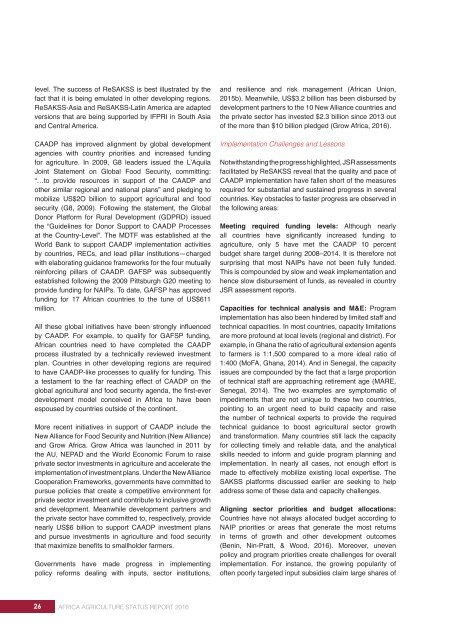AFRICA AGRICULTURE STATUS REPORT 2016
AASR-report_2016-1
AASR-report_2016-1
Create successful ePaper yourself
Turn your PDF publications into a flip-book with our unique Google optimized e-Paper software.
level. The success of ReSAKSS is best illustrated by the<br />
fact that it is being emulated in other developing regions.<br />
ReSAKSS-Asia and ReSAKSS-Latin America are adapted<br />
versions that are being supported by IFPRI in South Asia<br />
and Central America.<br />
CAADP has improved alignment by global development<br />
agencies with country priorities and increased funding<br />
for agriculture. In 2009, G8 leaders issued the L’Aquila<br />
Joint Statement on Global Food Security, committing:<br />
“…to provide resources in support of the CAADP and<br />
other similar regional and national plans” and pledging to<br />
mobilize US$2O billion to support agricultural and food<br />
security (G8, 2009). Following the statement, the Global<br />
Donor Platform for Rural Development (GDPRD) issued<br />
the “Guidelines for Donor Support to CAADP Processes<br />
at the Country-Level”. The MDTF was established at the<br />
World Bank to support CAADP implementation activities<br />
by countries, RECs, and lead pillar institutions—charged<br />
with elaborating guidance frameworks for the four mutually<br />
reinforcing pillars of CAADP. GAFSP was subsequently<br />
established following the 2009 Pittsburgh G20 meeting to<br />
provide funding for NAIPs. To date, GAFSP has approved<br />
funding for 17 African countries to the tune of US$611<br />
million.<br />
All these global initiatives have been strongly influenced<br />
by CAADP. For example, to qualify for GAFSP funding,<br />
African countries need to have completed the CAADP<br />
process illustrated by a technically reviewed investment<br />
plan. Countries in other developing regions are required<br />
to have CAADP-like processes to qualify for funding. This<br />
a testament to the far reaching effect of CAADP on the<br />
global agricultural and food security agenda, the first-ever<br />
development model conceived in Africa to have been<br />
espoused by countries outside of the continent.<br />
More recent initiatives in support of CAADP include the<br />
New Alliance for Food Security and Nutrition (New Alliance)<br />
and Grow Africa. Grow Africa was launched in 2011 by<br />
the AU, NEPAD and the World Economic Forum to raise<br />
private sector investments in agriculture and accelerate the<br />
implementation of investment plans. Under the New Alliance<br />
Cooperation Frameworks, governments have committed to<br />
pursue policies that create a competitive environment for<br />
private sector investment and contribute to inclusive growth<br />
and development. Meanwhile development partners and<br />
the private sector have committed to, respectively, provide<br />
nearly US$6 billion to support CAADP investment plans<br />
and pursue investments in agriculture and food security<br />
that maximize benefits to smallholder farmers.<br />
Governments have made progress in implementing<br />
policy reforms dealing with inputs, sector institutions,<br />
and resilience and risk management (African Union,<br />
2015b). Meanwhile, US$3.2 billion has been disbursed by<br />
development partners to the 10 New Alliance countries and<br />
the private sector has invested $2.3 billion since 2013 out<br />
of the more than $10 billion pledged (Grow Africa, <strong>2016</strong>).<br />
Implementation Challenges and Lessons<br />
Notwithstanding the progress highlighted, JSR assessments<br />
facilitated by ReSAKSS reveal that the quality and pace of<br />
CAADP implementation have fallen short of the measures<br />
required for substantial and sustained progress in several<br />
countries. Key obstacles to faster progress are observed in<br />
the following areas:<br />
Meeting required funding levels: Although nearly<br />
all countries have significantly increased funding to<br />
agriculture, only 5 have met the CAADP 10 percent<br />
budget share target during 2008–2014. It is therefore not<br />
surprising that most NAIPs have not been fully funded.<br />
This is compounded by slow and weak implementation and<br />
hence slow disbursement of funds, as revealed in country<br />
JSR assessment reports.<br />
Capacities for technical analysis and M&E: Program<br />
implementation has also been hindered by limited staff and<br />
technical capacities. In most countries, capacity limitations<br />
are more profound at local levels (regional and district). For<br />
example, in Ghana the ratio of agricultural extension agents<br />
to farmers is 1:1,500 compared to a more ideal ratio of<br />
1:400 (MoFA, Ghana, 2014). And in Senegal, the capacity<br />
issues are compounded by the fact that a large proportion<br />
of technical staff are approaching retirement age (MARE,<br />
Senegal, 2014). The two examples are symptomatic of<br />
impediments that are not unique to these two countries,<br />
pointing to an urgent need to build capacity and raise<br />
the number of technical experts to provide the required<br />
technical guidance to boost agricultural sector growth<br />
and transformation. Many countries still lack the capacity<br />
for collecting timely and reliable data, and the analytical<br />
skills needed to inform and guide program planning and<br />
implementation. In nearly all cases, not enough effort is<br />
made to effectively mobilize existing local expertise. The<br />
SAKSS platforms discussed earlier are seeking to help<br />
address some of these data and capacity challenges.<br />
Aligning sector priorities and budget allocations:<br />
Countries have not always allocated budget according to<br />
NAIP priorities or areas that generate the most returns<br />
in terms of growth and other development outcomes<br />
(Benin, Nin-Pratt, & Wood, <strong>2016</strong>). Moreover, uneven<br />
policy and program priorities create challenges for overall<br />
implementation. For instance, the growing popularity of<br />
often poorly targeted input subsidies claim large shares of<br />
26 <strong>AFRICA</strong> <strong>AGRICULTURE</strong> <strong>STATUS</strong> <strong>REPORT</strong> <strong>2016</strong>


